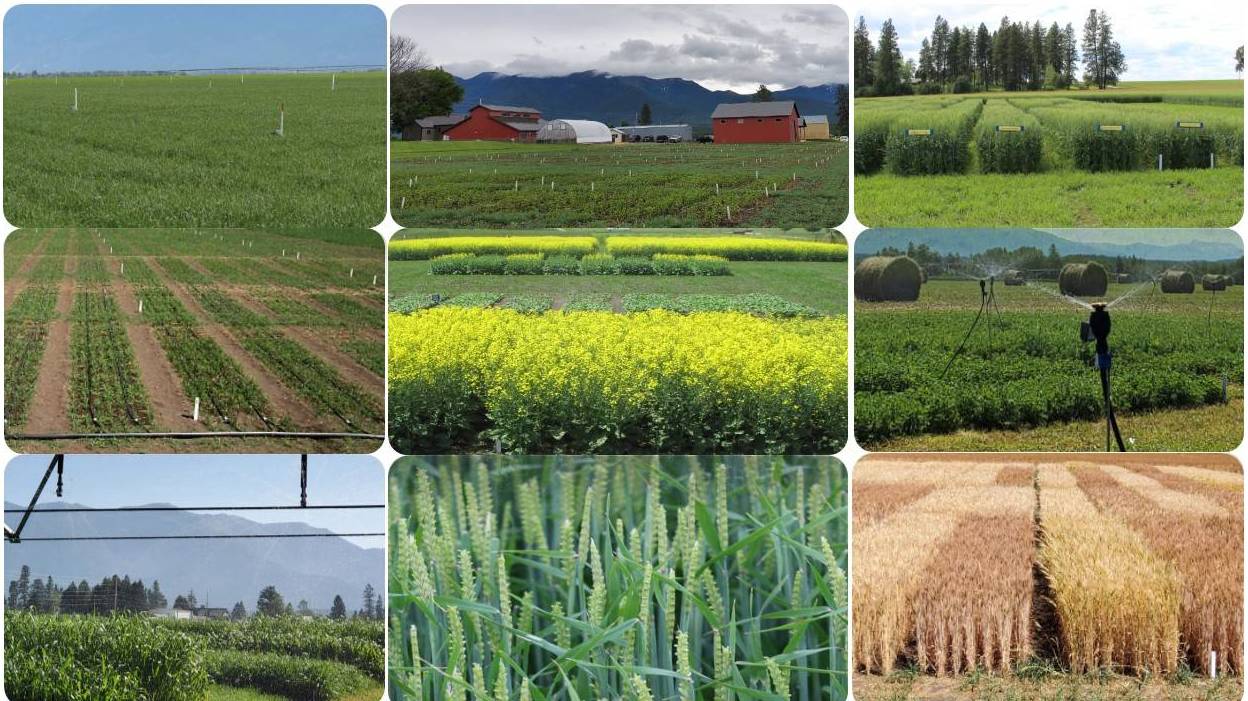Northwestern Agricultural Research Center
Crop Variety Selection Tool, click here to get to the webpages.

NWARC Faculty and Staff, 17 July 2025, Photo credit: Marcus "Doc" Craven, MSU Communications
The Northwestern Agricultural Research Center is one of seven off-campus research centers in the Department of Research Centers. The NWARC consists of 200 irrigated and dryland acres and is well-equipped with modern field plot equipment, laboratory equipment, facilities and greenhouse space. The research center is located 10 miles from Flathead Lake, the largest fresh water lake in the western U.S., and 45 miles from Glacier National Park.
Scientists and staff at NWARC are actively involved with local agriculture and enjoy interactions with area farmers, ranchers, and agribusiness people. They also work with the MSU Cooperative Extension Service to serve the widely-varied agricultural needs of our immediate area and Northwestern Montana.
History
NWARC, part of the Montana Agricultural Experiment Stations (MAES) and Montana State University, a land-grant university, was established by the 1947 legislature to conduct agricultural research to benefit producers in Montana, particularly in the following counties: Flathead, Sanders, Lake, and Lincoln. An advisory committee composed of three producers from each county meets twice a year to provide input on the future direction of research as well as outreach activities. Read more about the history of the NWARC here.

Areas of Research
In the early years, research was conducted on both livestock and crops, with an emphasis on sheep and cereal production. Over time, research was redirected to focus more specifically on crop production. Research at NWARC has always been responsive to the needs of the local producers, particularly with respect to market fluctuations. And so, research has been conducted on various crops over time, and has included peppermint, spearmint, potatoes and camelina, to name a few. Currently, our research efforts target production issues in spring and winter wheat, barley, canola, dry peas, lentils, and forage crops.
Our crop research can be broadly classified into two complementary areas; cropping systems with emphasis on pest management (biotic stress) and field crop physiology of non-living growing conditions and factors (abiotic stress).
Pest research initially emphasized weed management issues, but has evolved to include plant disease and insect pests as well. And as new pests appear in the region, research is redirected in order to develop management strategies to combat the new threat. Regardless of the pest, integrated approaches are sought that include both short term and long term solutions that are economically and environmentally sustainable.
Most recently, economic and environmental imperatives have resulted in a redirection of research emphasis to focus on crop nutrient use efficiency and water use efficiency. These two factors are essential for optimum crop production and quality, and will be increasingly important resources to manage wisely as NWARC continues to meet the future demands of Montana’s agricultural producers and aligned industries.
Mission
The mission of the Montana Agricultural Experiment Station and its Research Centers is to conduct and promote studies, scientific investigations, and experiments relating to agriculture, natural resources and rural life and to diffuse information thereby acquired among the people of Montana; to identify solutions to problems and provide input on issues that impact the agricultural industry. The goal of the MAES is to conduct research that will maintain the vitality of Montana's agricultural industry.
USDA Non Discrimination Statement
In accordance with Federal civil rights law and U.S. Department of Agriculture (USDA) civil rights regulations and policies, the USDA, its Agencies, offices, and employees, and institutions participating in or administering USDA programs are prohibited from discriminating based on race, color, national origin, religion, sex, gender identity (including gender expression), sexual orientation, disability, age, marital status, family/parental status, income derived from a public assistance program, political beliefs, or reprisal or retaliation for prior civil rights activity, in any program or activity conducted or funded by USDA (not all bases apply to all programs). Remedies and complaint filing deadlines vary by program or incident.
Persons with disabilities who require alternative means of communication for program information (e.g., Braille, large print, audiotape, American Sign Language, etc.) should contact the responsible Agency or USDA's TARGET Center at (202) 720-2600 (voice and TTY) or contact USDA through the Federal Relay Service at (800) 877-8339. Additionally, program information may be made available in languages other than English.
To file a program discrimination complaint, complete the USDA Program Discrimination Complaint Form, AD-3027, found online at How to File a Program Discrimination Complaint and at any USDA office or write a letter addressed to USDA and provide in the letter all of the information requested in the form. To request a copy of the complaint form, call (866) 632-9992. Submit your completed form or letter to USDA by: (1) mail: U.S. Department of Agriculture, Office of the Assistant Secretary for Civil Rights, 1400 Independence Avenue, SW, Washington, D.C. 20250-9410; (2) fax: (202) 690-7442; or (3) email: program.intake@usda.gov.
USDA is an equal opportunity provider, employer, and lender.

